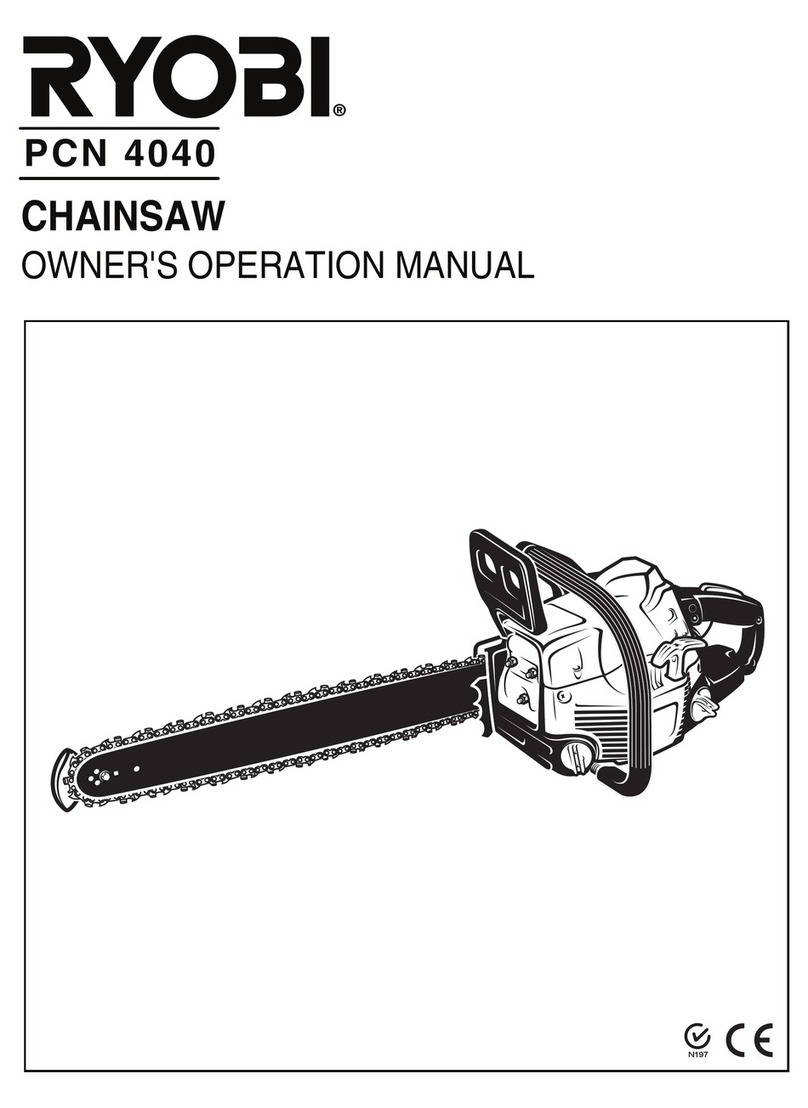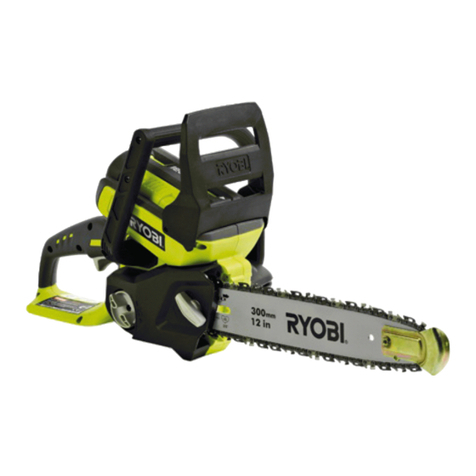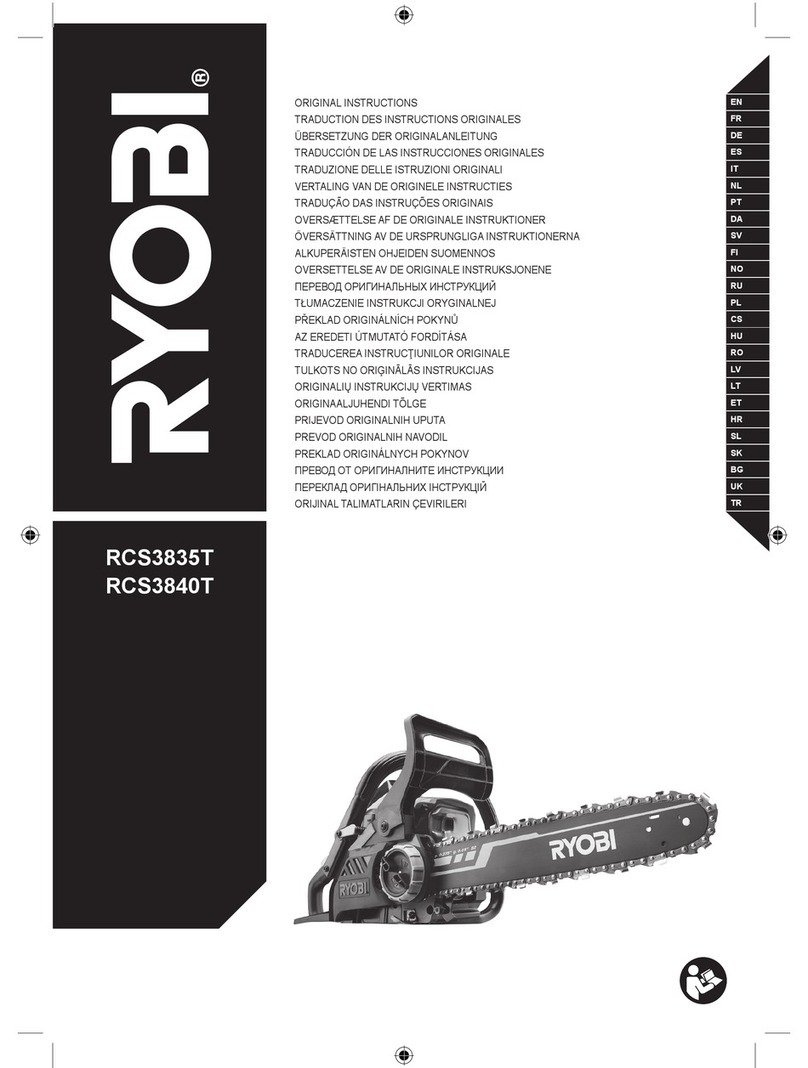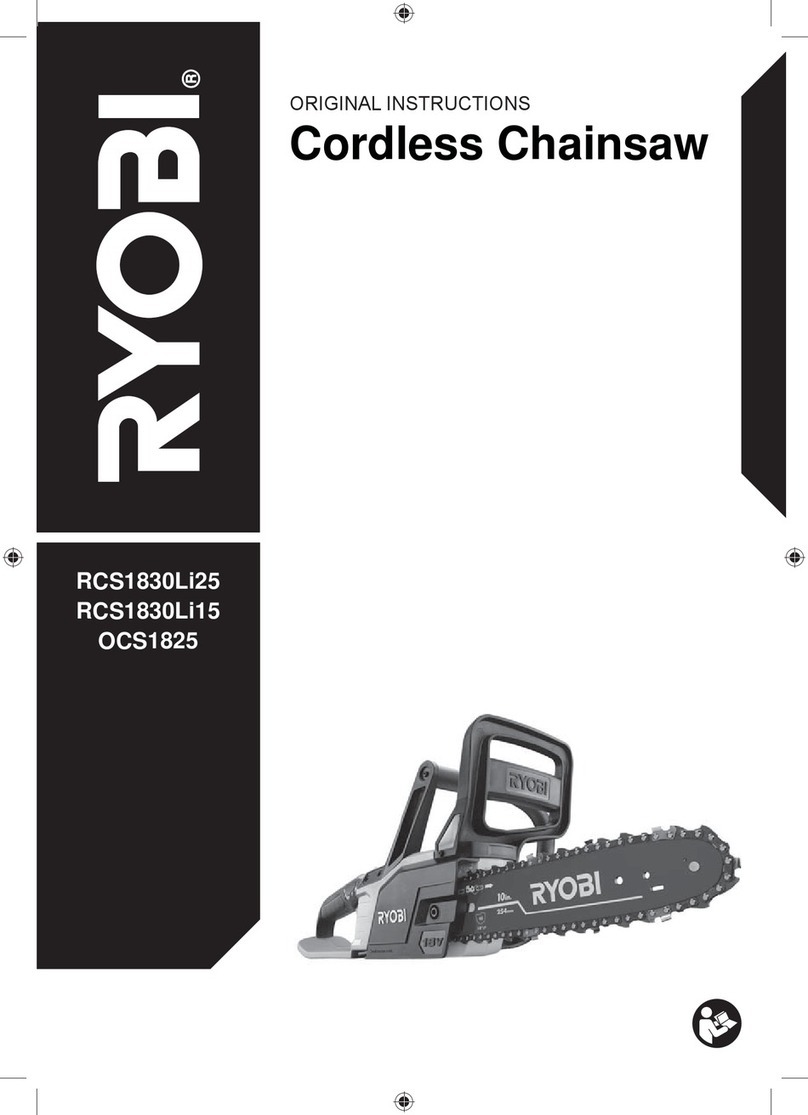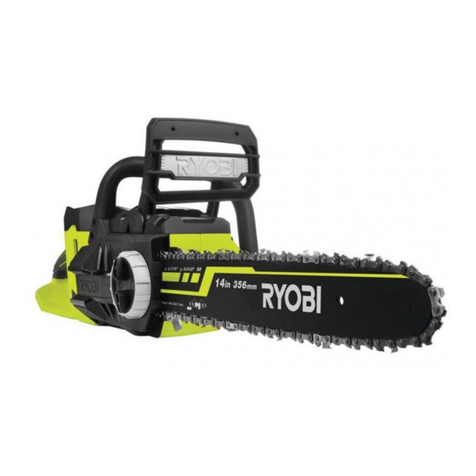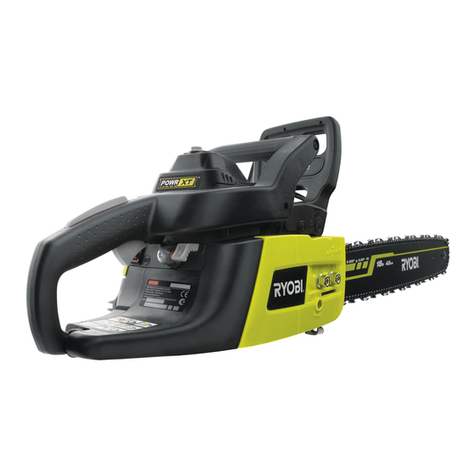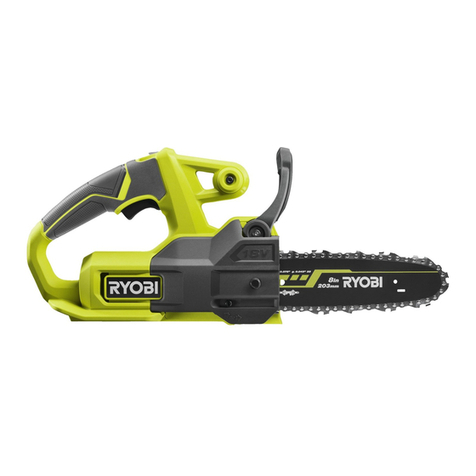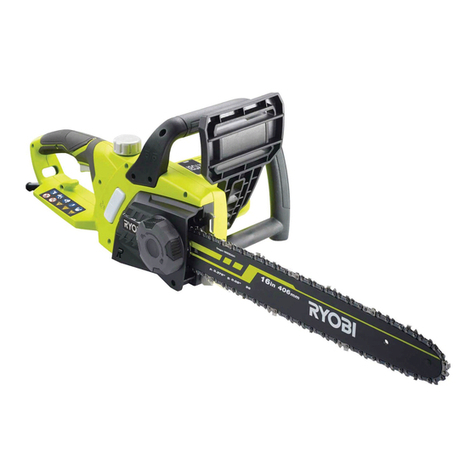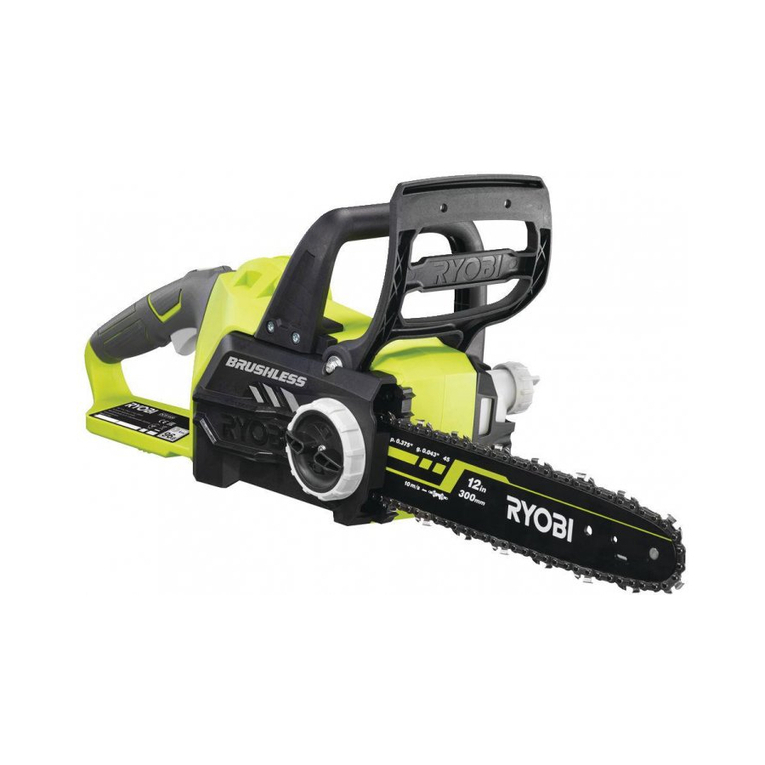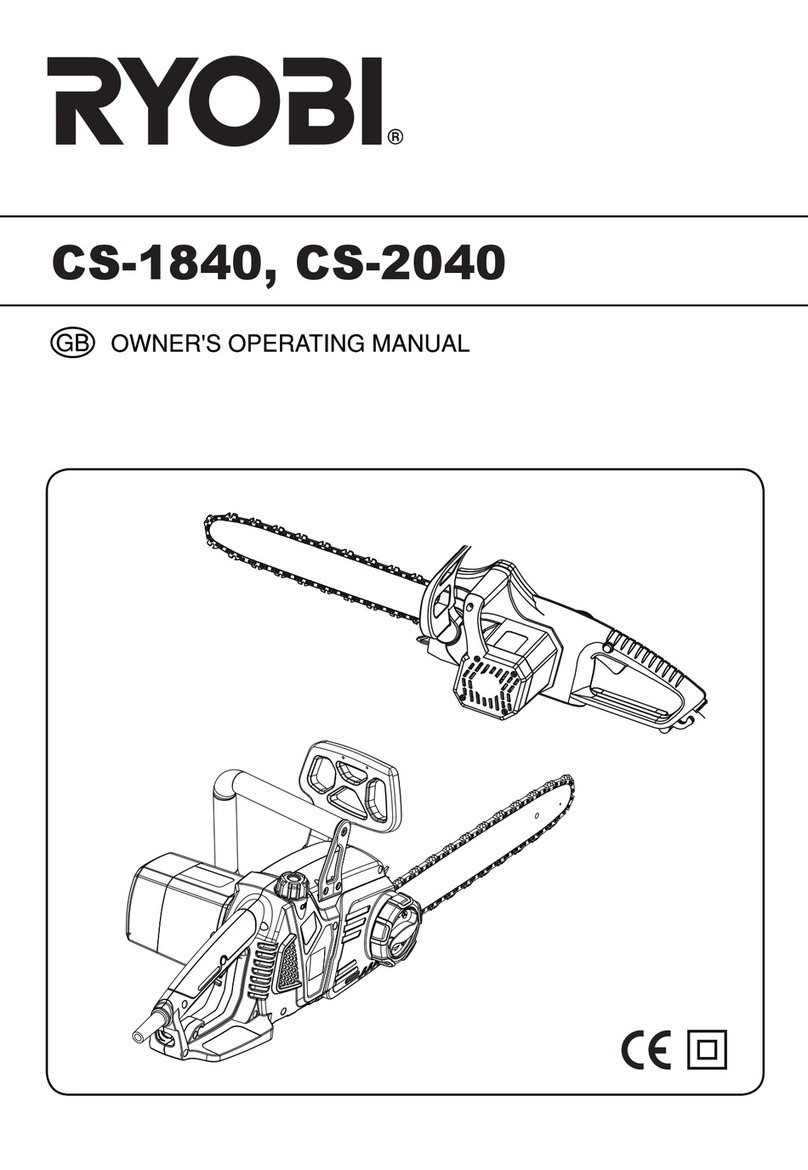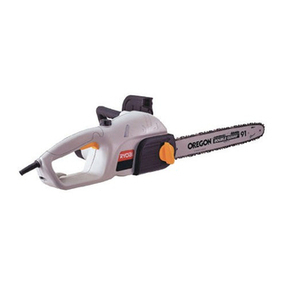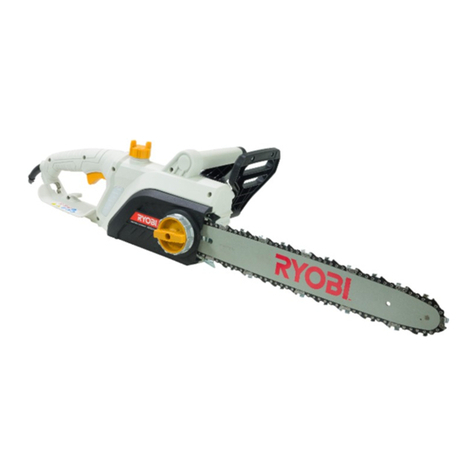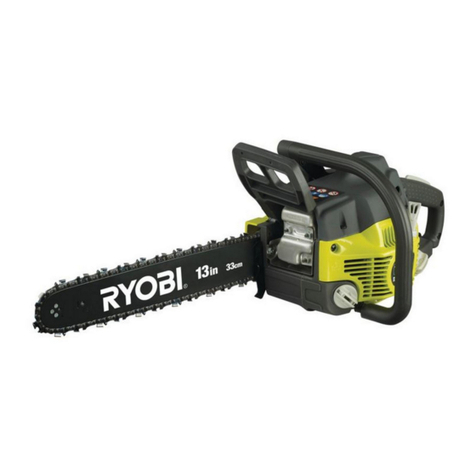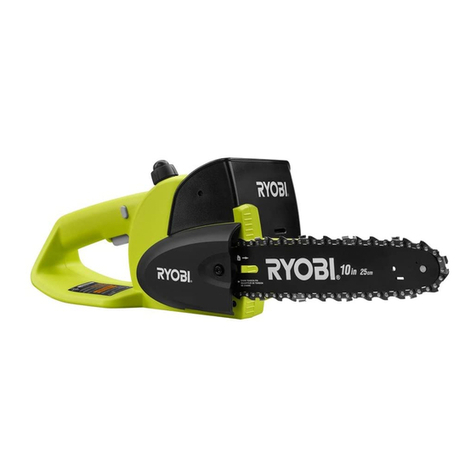3English |
EN
FR
DE
ES
IT
NL
PT
DA
SV
FI
NO
RU
PL
CS
HU
RO
LV
LT
ET
HR
SL
SK
BG
a chainsaw while up in a tree may result in personal
injury.
ŶAlways keep proper footing and operate the
chainsaw only when standing on fixed, secure and
level surface. Slippery or unstable surfaces such as
ladders may cause a loss of balance or control of the
chainsaw.
ŶWhen cutting a limb that is under tension be alert
for spring back. When the tension in the wood fibres is
UHOHDVHGWKHVSULQJORDGHGOLPEPD\VWULNHWKHRSHUDWRU
DQGRUWKURZWKHFKDLQVDZRXWRIFRQWURO
ŶUse extreme caution when cutting brush and
saplings. The slender material may catch the saw
chain and be whipped toward you or pull you off
balance.
ŶCarry the chainsaw by the front handle with the
chainsaw switched off and away from your body.
When transporting or storing the chainsaw always
fit the guide bar cover. 3URSHU KDQGOLQJ RI WKH
FKDLQVDZZLOOUHGXFHWKHOLNHOLKRRGRIDFFLGHQWDOFRQWDFW
with the moving saw chain.
ŶFollow instructions for lubricating, chain tensioning
and changing accessories. Improperly tensioned
RU OXEULFDWHG FKDLQ PD\ HLWKHU EUHDN RU LQFUHDVH WKH
FKDQFHIRUNLFNEDFN
ŶKeep handles dry, clean, and free from oil and
grease. Greasy, oily handles are slippery causing loss
of control.
ŶCut wood only. Do not use chainsaw for purposes
not intended. For example: do not use chainsaw
for cutting plastic, masonry or non-wood building
materials. Use of the chainsaw for operations different
than intended could result in a hazardous situation.
Causes and operator prevention of kickback:
.LFNEDFNPD\RFFXUZKHQWKHQRVHRUWLSRIWKHJXLGHEDU
touches an object, or when the wood closes in and pinches
the saw chain in the cut.
Tip contact in some cases may cause a sudden reverse
UHDFWLRQ NLFNLQJ WKH JXLGH EDU XS DQG EDFN WRZDUGV WKH
operator.
3LQFKLQJWKHVDZFKDLQDORQJWKHWRSRIWKHJXLGHEDUPD\
SXVKWKHJXLGHEDUUDSLGO\EDFNWRZDUGVWKHRSHUDWRU
Either of these reactions may cause you to lose control of
the saw which could result in serious personal injury. Do
not rely exclusively upon the safety devices built into your
VDZ$VDFKDLQVDZXVHU\RXVKRXOGWDNHVHYHUDOVWHSVWR
NHHS\RXUFXWWLQJMREVIUHHIURPDFFLGHQWRULQMXU\
.LFNEDFN LV WKH UHVXOW RI WRRO PLVXVH DQGRU LQFRUUHFW
operating procedures or conditions and can be avoided by
WDNLQJSURSHUSUHFDXWLRQVDVJLYHQEHORZ
ŶMaintain a firm grip, with thumbs and fingers
encircling the chainsaw handles, with both hands
on the saw and position your body and arm to allow
you to resist kickback forces. .LFNEDFN IRUFHV FDQ
be controlled by the operator, if proper precautions are
WDNHQ'RQRWOHWJRRIWKHFKDLQVDZ
ŶDo not overreach and do not cut above shoulder
height. This helps prevent unintended tip contact and
enables better control of the chainsaw in unexpected
situations.
ŶOnly use replacement bars and chains specified
by the manufacturer. Incorrect replacement bars and
FKDLQVPD\FDXVHFKDLQEUHDNDJHDQGRUNLFNEDFN
ŶFollow the manufacturer’s sharpening and
maintenance instructions for the saw chain.
Decreasing the depth gauge height can lead to
LQFUHDVHGNLFNEDFN
ADDITIONAL CHAINSAW SAFETY WARNINGS
Ŷ,WLVUHFRPPHQGHGWRFXWORJVRQDVDZKRUVHRUFUDGOH
when operating the product the first time.
Ŷ(QVXUH DOO JXDUGV KDQGOHV DQG VSLNHG EXPSHU DUH
properly fitted and are in good condition.
Ŷ3HUVRQVXVLQJWKLVFKDLQVDZVKRXOGEHLQJRRGKHDOWK
7KHFKDLQVDZLVDKHDY\XQLWVRWKHRSHUDWRUUHTXLUHV
to be physically fit. The operator should be alert, have
good vision, mobility, balance and manual dexterity. If
there is any doubt, do not operate the chainsaw.
ŶDo not start using the product until you have a clear
ZRUNDUHDVHFXUHIRRWLQJDQGDSODQQHGUHWUHDWSDWK
away from the falling tree.
ŶBeware of the emission of lubricant mist and saw dust.
:HDUDPDVNRUUHVSLUDWRULIUHTXLUHG
Ŷ'RQRWFXWYLQHVDQGRUVPDOOXQGHUJURZWKOHVVWKDQ
PPLQGLDPHWHU
ŶAlways hold the chainsaw with both hands when
operating the saw. Use a firm grip with thumbs and
fingers encircling the chainsaw handles. Right hand
must be on the rear handle and left hand on the front
handle.
Ŷ%HIRUHVWDUWLQJWKHWRROPDNHVXUHWKHVDZFKDLQLVQRW
contacting any object.
ŶDo not modify your tool in any way or use it to power
any attachments or devices not recommended by the
manufacturer for your saw.
Ŷ7KHUH VKRXOG EH D ILUVWDLG NLW FRQWDLQLQJ ODUJH
wound dressings and a means to summon attention
HJ ZKLVWOH FORVH WR WKH RSHUDWRU $ ODUJHU PRUH
FRPSUHKHQVLYHNLWVKRXOGEHUHDVRQDEO\QHDUE\
ŶThe operator may be tempted to remove the helmet if
WKHUHLVQRGDQJHURIIDOOLQJREMHFWVLQWKHZRUNDUHDEXW
remember the helmet, particularly with the mesh visor,
can help reduce the potential for injury to the face and
KHDGLINLFNEDFNRFFXUV
ŶAn incorrectly tensioned chain can jump off the guide
bar and could result in serious injury or fatality. The
OHQJWKRIFKDLQGHSHQGVRQWKHWHPSHUDWXUH&KHFNWKH
WHQVLRQIUHTXHQWO\
Ŷ<RXVKRXOGJHWXVHGWR\RXUQHZFKDLQVDZE\PDNLQJ
simple cuts on securely supported wood. Do this
whenever you have not operated the saw for some
time.
Ŷ7RUHGXFHWKHULVNRILQMXU\DVVRFLDWHGZLWKFRQWDFWLQJ
PRYLQJSDUWVDOZD\VVWRSWKHPRWRUDSSO\FKDLQEUDNH
UHPRYH WKH EDWWHU\ SDFN DQG PDNH VXUH DOO PRYLQJ
SDUWVKDYHFRPHWRDVWRSEHIRUH
–FOHDQLQJRUFOHDULQJDEORFNDJH
–leaving the product unattended
